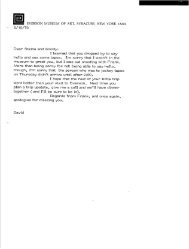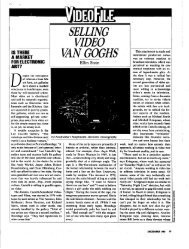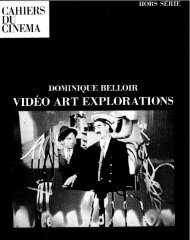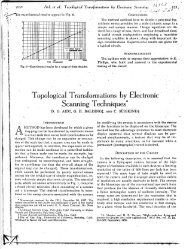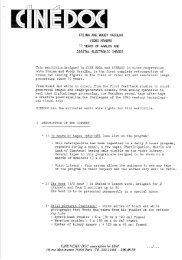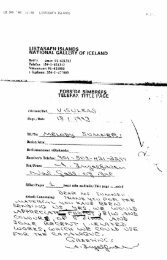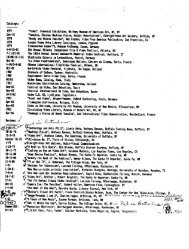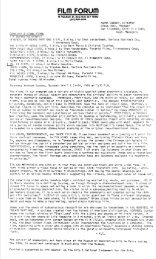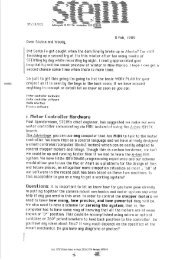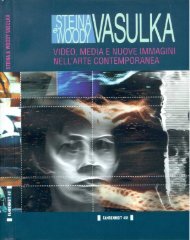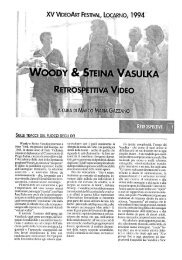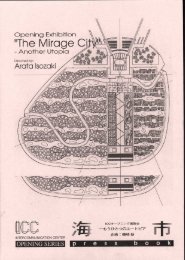MEDIA STUDY/BUFFALO - the Vasulkas
MEDIA STUDY/BUFFALO - the Vasulkas
MEDIA STUDY/BUFFALO - the Vasulkas
Create successful ePaper yourself
Turn your PDF publications into a flip-book with our unique Google optimized e-Paper software.
Scene from Maeve by Pat Murphy and John Davies .<br />
April 20 (Friday)<br />
8 :00 PM<br />
207 Delaware Avenue<br />
ANIMATION FOR LIVE ACTION<br />
(1978)<br />
Directed, written, animated, and edited<br />
by Vera Neubauer. With Ken Parry,<br />
Renate Schowald, and Jewels Walters.<br />
26 minutes .<br />
The remarkable visual invention evident<br />
in Vera Neubauer's Animation for<br />
Live Action is enlisted into that venerable<br />
tradition in animation whereby <strong>the</strong><br />
live-action creator is shown in <strong>the</strong><br />
process of drawing his creations, who<br />
<strong>the</strong>n magically spring to life, typically<br />
to challenge <strong>the</strong> creator's god-like<br />
authority .<br />
MAEVE (1981)<br />
Directed by Pat Murphy and John Davies<br />
. With Mary Jackson, Mark Mulholland,<br />
Brid Brennan, and Trudy Kelly.<br />
110 minutes .<br />
Peter Greenaway's The Falls.<br />
In Maeve, <strong>the</strong> apparently endless "troubles"<br />
in Nor<strong>the</strong>rn Ireland are filtered<br />
through <strong>the</strong> perceptions of Maeve<br />
Sweeney, a young woman visiting her<br />
family in Belfast from her new home in<br />
London . Once back in <strong>the</strong> neighborhood<br />
of her youth (a Republican<br />
stronghold), <strong>the</strong> past comes flooding<br />
back through her own memories, seen<br />
in flashback, and through those of her<br />
parents and sister, whose story-tellings<br />
constitute a kind of oral tradition of<br />
which she comes to see she is part .<br />
Particularly critical of <strong>the</strong> range of<br />
models available to women in Catholic<br />
Nor<strong>the</strong>rn Ireland (notably <strong>the</strong> mo<strong>the</strong>ras-martyr<br />
posture espoused by women<br />
whose sons have been murdered by<br />
<strong>the</strong> British occupying forces), Maeve<br />
joins its inquiry into how women should<br />
live in contemporary Belfast society-a<br />
colonized country-with a broader political<br />
inquiry into <strong>the</strong> status of Republicanism<br />
itself as it inflects <strong>the</strong> lives and<br />
behavior of one Catholic family.<br />
Stiff Little Fingers perform in Rough CutandReady Dubbed by Hasan Shah and Dom Shaw.<br />
April 26 (Thursday)<br />
8:00 PM<br />
207 Delaware<br />
FREE CINEMA AND BEYOND<br />
O Dreamland (1953)<br />
Directed by Lindsay Anderson . 11<br />
minutes .<br />
Momma Don't Allow (1956)<br />
Directed by Karel Reisz and Tony<br />
Richardson . With <strong>the</strong> Chris Barber<br />
Band . 22 minutes<br />
Nice Time (1957)<br />
Directed by Claude Goretta and Alain<br />
Tanner. 17 minutes.-<br />
Rough Cut and Ready Dubbed<br />
(1982)<br />
Directed and produced by Hasan Shah<br />
and Dom Shaw. With Patrik Fitzgerald,<br />
Colin Peacock, Jake Burns, and Stiff<br />
Little Fingers . 58 minutes .<br />
Free Cinema flourished in Britain from<br />
<strong>the</strong> middle to late 1950s, more a tendency<br />
than a full-scale movement . Opposed<br />
to <strong>the</strong> style and content of<br />
mainstream British filmmaking of <strong>the</strong><br />
day, Free Cinema films expressed a<br />
belief in <strong>the</strong> interest of everyday working<br />
class life which could be cinematically<br />
rendered in "personal"<br />
documentaries without concern for <strong>the</strong><br />
constraints of commercial filmmaking .<br />
In O Dreamland, Lindsay Anderson examines<br />
<strong>the</strong> world of <strong>the</strong> "Dreamland"<br />
funfair in Margate, Kent, <strong>the</strong> seaside<br />
resort where Londoners (more skeptical<br />
than mirthful) often travel to spend<br />
a day among <strong>the</strong> shopworn thrills and<br />
diversions . Karel Reisz's and Tony<br />
Richardson's Momma Don't Allow<br />
depicts <strong>the</strong> emerging youth culture (in<br />
this respect a forerunner of a film like<br />
Rough Cut and Ready Dubbed) within<br />
<strong>the</strong> context of a north London jazz club<br />
frequented by working class youth (and<br />
<strong>the</strong> occasional middle class guests out<br />
for a night of "slumming") . In Nice<br />
Time, Claude Goretta and Alain Tanner,<br />
two Swiss filmmakers working at <strong>the</strong><br />
BFI who would go on to international<br />
acclaim in <strong>the</strong> 1970s, sketch an impressionistic<br />
view of <strong>the</strong> nightlife in London's<br />
Piccadilly Circus-in <strong>the</strong>ir words,<br />
"an attempt to catch and interpret <strong>the</strong><br />
responses of <strong>the</strong> crowd to <strong>the</strong> fare it is<br />
offered ."<br />
The "rough cut" quality of Rough Cut<br />
and Ready Dubbed underpins both<br />
literal and figurative levels . Blown up<br />
from Super-8 to 16mm, <strong>the</strong> film<br />
achieves a jaggedly sensuous visual<br />
quality appropriate to its subject, complemented<br />
by an editorial attitude allowing<br />
conflicting viewpoints to thrash<br />
it out among <strong>the</strong>mselves. Most of <strong>the</strong><br />
footage captures live performances in<br />
1979 and 1980 of British post-punk<br />
bands, between which are interspersed<br />
interviews and commentaries by musicians<br />
and Music journalists from New<br />
Musical Express and Sounds .<br />
April 27 (Friday)<br />
8:00 PM<br />
207 Delaware Avenue<br />
PETER GREENAWAY<br />
(In Person)<br />
The Falls (1980)<br />
Directed, written, and edited by Peter<br />
Greenaway . With Peter Westley, Aad<br />
Wirtz, Michael Murray, and Lorna<br />
Poulter. 185 minutes .<br />
In <strong>the</strong> pre-history of <strong>the</strong> fictive universe<br />
constructed in The Falls stands<br />
"VUE'=<strong>the</strong> o<strong>the</strong>rwise unexplained<br />
Violent Unknown Event on whose<br />
cataclysmic results <strong>the</strong> film reports .<br />
Working in <strong>the</strong> wake of <strong>the</strong> VUE (an incomprehensible<br />
catastrophe suspected<br />
of being caused, somehow, by <strong>the</strong><br />
relations people bear to birds, and having,<br />
among o<strong>the</strong>rs, as consequences,<br />
<strong>the</strong> multiplication of sex roles from two<br />
to four and <strong>the</strong> haphazard mutation of<br />
humans into birds), Peter Greenaway's<br />
intent is to provide capsule biographies<br />
of VUE victims and <strong>the</strong>reby to illuminate<br />
<strong>the</strong> genesis moment of <strong>the</strong><br />
postVUE world . To do this he consults<br />
<strong>the</strong> VUE Doomsday Directory listing all<br />
19 million victims, and randomly<br />
selects those whose surnames begin<br />
with <strong>the</strong> prefix "Fall," from Falla to Fallwaste<br />
. These number 92, coincidentally<br />
<strong>the</strong> same number as that of new<br />
languages generated in <strong>the</strong> VUE's<br />
aftermath . The Falls, <strong>the</strong>n, consists of<br />
this project : 92 biographies of VUE victims,<br />
all given in differing styles but<br />
linked by such standard documentary<br />
guarantees as <strong>the</strong> objective voice-over<br />
commentator, interviews with experts,<br />
and a reliance on <strong>the</strong> factual-all of its<br />
erudition invented to give credence to<br />
<strong>the</strong> world of this dead-pan epic.<br />
17



